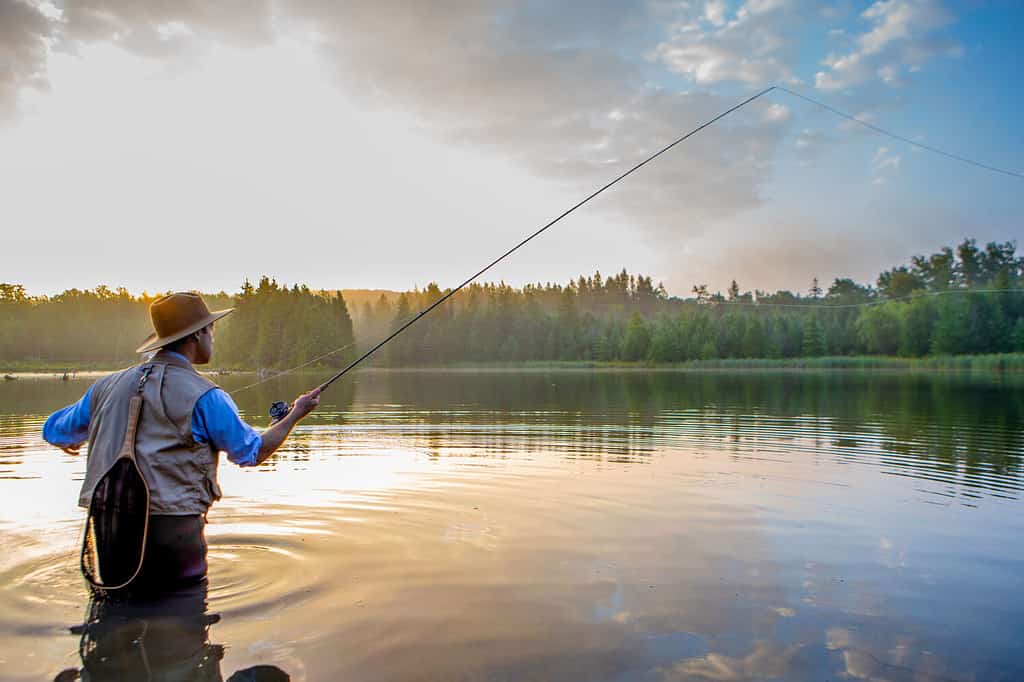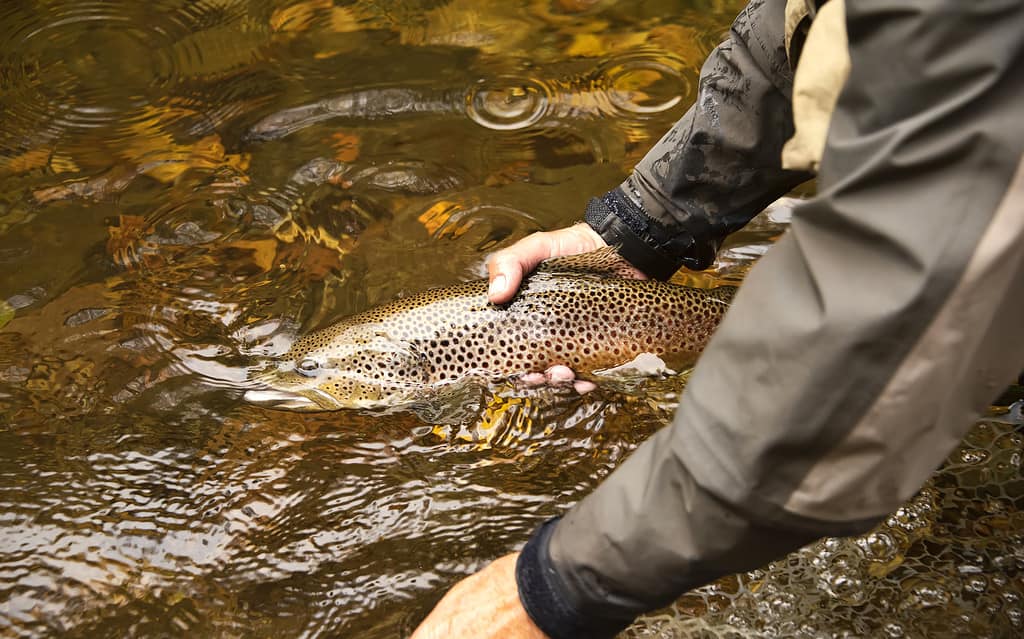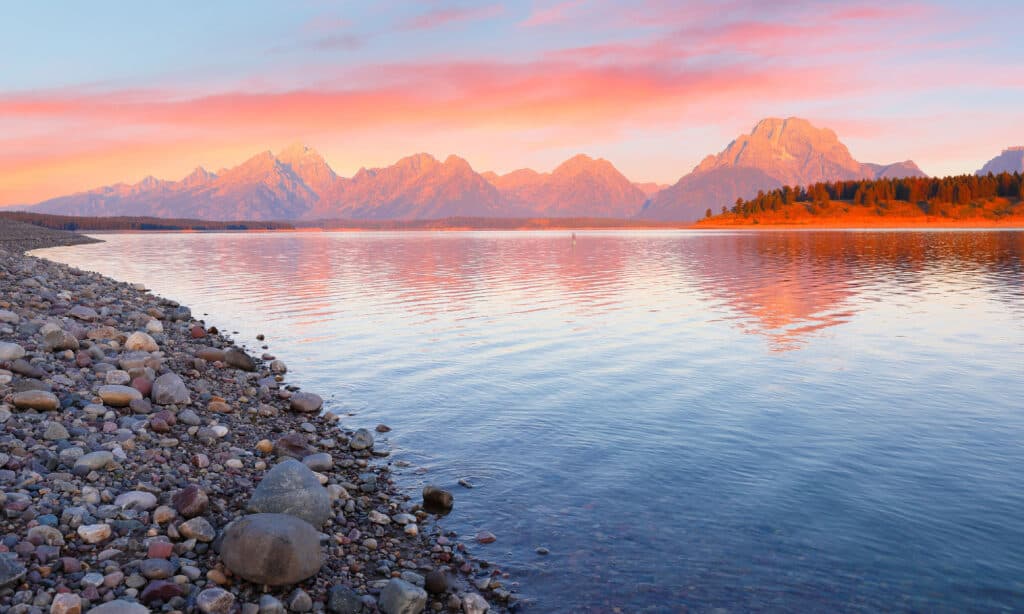Welcome to Jackson Lake, the ideal escape from city life, offering tranquility amidst nature’s embrace. The breathtaking Teton Range nestles this oasis in northwest Wyoming. Delight in the crystal-clear waters teeming with diverse fish species, making it an angler’s paradise. Jackson Lake offers unparalleled fishing opportunities, whether casting from a boat or wading in the shallows.
Join us as we uncover the secrets of this magnificent lake, including its impressive size, depth, and undeniable status as a natural wonder.
Battling the Forces of Nature: The History and Evolution of Jackson Lake
Throughout its existence, Jackson Lake has undergone notable transformations from its glacial origins—initially, a smaller body of water formed by sculpting and melting glaciers. However, human intervention was crucial in expanding the lake to its present size. A temporary log and mud dam was constructed in 1907 to address the recurring issue of spring floods. However, it did not succeed in raising the water level. Despite these challenges, the quest for a lasting solution to this perennial problem continued.
In 1910, a significant event occurred when the dam at Jackson Lake broke, prompting the Bureau of Reclamation to take action toward constructing a more reliable and enduring structure. By 1911, the concrete form of the Jackson Lake Dam was completed, increasing its height. However, further enhancements were deemed necessary, leading to an additional extension in 1916, which added 17 feet to its height. This significant expansion enabled the dam to store an impressive increase of over 847,000 acre-feet of water compared to its previous capacity.
Over time, Jackson Dam and Lake became essential for farmers, providing a crucial water supply during dry seasons. Concerns arose regarding the dam’s structural integrity, but advancements in building techniques led to a complete reconstruction in 1989, ensuring enhanced safety. Today, Jackson Lake offers a serene escape, inviting people to unwind amidst stunning landscapes and a tranquil ambiance.

Jackson Dam and Lake became essential for farmers and provided crucial water supply during dry seasons.
©Michael Liggett/Shutterstock.com
Jackson Lake: Where Nature’s Majesty Meets Human Ingenuity
When visitors explore Grand Teton National Park, one location truly captivates their attention – Jackson Lake. This remarkable body of water spans over 25,540 acres and reaches a depth of 438 feet, making it one of the largest high-altitude lakes in the United States. It commands respect and leaves visitors in awe of its grandeur.
Sitting at an elevation of 2,064 meters above sea level, this lake’s glacial blue waters brim with vibrant life, enhancing its already breathtaking beauty. The Snake River primarily feeds the lake, contributing to its pristine quality. Despite being so large and deep, the water of the lake averages a temperature of 60 °F even during summer.
A fascinating aspect of Jackson Lake is its abundance of islands, with over fifteen scattered across its vast expanse. Among them, Elk Island stands as the largest, while Donoho Point adds its enchanting allure. These picturesque islands not only enhance the scenic beauty of the lake but also provide fishermen with ample opportunities to indulge in angling amidst the serene surroundings of their shores.
The Memorial Parkway is situated near the northern tip of Jackson Lake, stretching to the south entrance of Yellowstone National Park. This historic site extends into a wildlife-rich area, providing a captivating experience. Witness the majestic elks roaming freely amidst the stunning wilderness, allowing visitors to indulge in nature’s awe-inspiring beauty and untamed magnificence.
Casting a Line in the Jewel of the Tetons: The Ultimate Guide to Fishing at Jackson Lake
Jackson Lake offers anglers an exceptional opportunity to catch prized fish. With its cold, deep waters, it is renowned as one of the finest fishing spots in the area. Teeming with diverse fish species, anglers can anticipate thrilling encounters on their fishing expeditions. Against the backdrop of the majestic Tetons and enveloped by lush green woods, this tranquil and awe-inspiring view evokes a sense of serenity and excitement all at once.
Anglers often prefer fishing from boats or tubes on Jackson Lake due to its expansive size and depth. However, fishing from the shore near the lake’s inlets and tailwaters also offers great opportunities. As the ice melts along the shallows in early to mid-May, anglers can have a fruitful fishing experience, especially when casting their lines between various points, enticing the fish to bite.
The prime fishing season at Jackson Lake spans from June to September when temperatures soar. However, certain summer fish species have specific criteria for optimal fishing. As autumn approaches and mid-September near, temperatures gradually cool, triggering fish spawning. This natural spectacle is most visible during sunset or late at night, offering an exceptional opportunity for visitors to witness this fascinating phenomenon.
Jackson Lake welcomes anglers from the fourth Saturday in April until October 31, providing ample opportunity to harvest stocked rainbow trout. It’s a seasonal haven for fishing enthusiasts seeking a rewarding catch and a memorable experience in a picturesque setting.

The prime fishing season at Jackson Lake spans from June to September when temperatures soar.
©GROGL/Shutterstock.com
Jackson Lake’s Finest: A Look at the Common Species Anglers Love to Catch
From trophy-sized catches to unique fish fauna, Jackson Lake boasts a diverse fish population that will lure any angler. Here are some common species.
Lake trout
Jackson Lake is known for its vast population of lake trout. These magnificent creatures are a sight to behold, with their cream-colored spots sprawling from head to tail on a striking greenish body. The lower fins add a pop of vibrant color, usually orange-red. One may mistake them for speckled jewels swimming in the cold water.
The lake trout’s ability to survive in low-nutrient water is impressive. They thrive in bodies with high dissolved oxygen levels but require solitude for much of the year. They are true loners who prefer to reside in the depths until the breeding season rolls around in September and October. When it comes to feeding, these piscivores are not picky eaters. They enjoy a wide range of prey, making them an integral part of Jackson Lake’s ecosystem. Unfortunately, overfishing and predation by sea lampreys put them at risk.
Despite their seemingly modest size, averaging 19 inches in length, these remarkable fish can surprise with weights of up to 15 pounds or more – a thrilling challenge to reel in. However, their true growth potential is even more astonishing. Fishing regulations limit the number of catches per day to safeguard their population against human interference and natural predators. Each person is permitted a daily creel limit of six fish, with only one exceeding 24 inches in length.
Brown Trout
Brown trout – the savvy master of deception in Jackson Lake, hides underwater and can blend in very well with its surroundings. The creatures have brown or olive-green bodies with dark spots that can look like waving weeds from far away. Their undersides are tannish, providing excellent camouflage from predators.
Whether you’re fishing for sport or sustenance, brown trout is genuinely nature’s gem. They are a fisherman’s most sought-after target, with an adult length ranging from 7 to 22 inches and weighing anywhere between 1 to 52 pounds.
Female brown trout have larger abdomens and smaller heads than males. Brown trout are renowned for their lively and amiable nature. Feeding small creatures and occasionally preying on other fish as they mature, they are a prized catch among anglers. However, their introduction can have adverse effects on native fish species. Ironically, this can lead to changes in algal biomass within specific water bodies, highlighting the complex ecological dynamics at play.

Adult brown trout can weigh between 1-52 pounds and measure 7-22 inches.
©iStock.com/Ruth Peterkin
Chinook Salmon
The magnificent Chinook salmon in Jackson Lake catches the eye with its vibrant blue-green back and glistening silver sides, reflecting the sunlight. Its distinct black speckles along the back and dorsal tail fin add to its sleek appearance. Notably, Chinook salmon feature relatively small eyes and unique blackish gums, setting them apart from other salmon species.
During spawning season, Chinook salmon change color to a vibrant reddish hue on their sides. It’s easy to spot male Chinook salmon at the time. They have hooked snouts and rigid backs that make them stand out. This type is the biggest salmon, growing up to 5 feet long and weighing 100 pounds. That’s like hauling around two sacks of potatoes while trying to reel in your catch. In maturity, adult Chinook salmon primarily feed on other fishes in the ocean. At the same time, fry and smolt are content with plankton, terrestrial and aquatic insects, or amphipods, making them vital members of Jackson Lake’s ecosystem.
Utah Chubs
Utah chubs like to live in areas with lots of plants. They prefer sandy or muddy places to hide from predators and be at peace. These fish have compact bodies, olive or dark blue backs, and lighter bellies. Their sides are yellowish, and their fins are either dull olive or yellow. They can observe every detail of their underwater world with relatively large eyes. Although they may not be flashy, these fish should not be underestimated.
The Utah chub is a small fish, typically reaching 5 to 8 inches long and weighing about one pound. Despite its size, it has impressive survival abilities. It can eat plants, insects, and crustaceans. This is a reminder of how vital every creature in an ecosystem is for its sustainability. Regarding reproductive abilities, Utah chubs become sexually mature at around three or four years of age.
Pike
These fierce and aggressive predators have distinct physical characteristics. They have long bodies with a prominent snout filled with sharp teeth, ideal for capturing their prey. Pike display a mottled greenish-brown coloration along their backs, which helps them blend into their surroundings, while their sides and belly are lighter in color.
Pike can be found in a variety of habitats in Lake Jackson, including weedy patches, submerged vegetation, and near drop-offs. They have been observed in both shallow and deep waters, depending on the season and food availability. During the warmer months, pike frequently seek cooler and deeper areas of the lake to stay cool.
As apex predators, pike eat a variety of foods and are opportunistic feeders. They primarily eat small fish like minnows, perch, and shiners. If given the opportunity, they have been known to consume frogs, crayfish, and even small mammals. Anglers love them because of their ravenous hunger and combative temperament.

Pike can be found near weedy patches, submerged vegetation, and drop-offs. Their adaptable nature leads them to both shallow and deep waters, following the seasons and food sources.
©Rostislav Stefanek/Shutterstock.com
Thrilling Adventure Awaits, But Safety Comes First: Tips to Ensure a Safe Visit to Jackson Lake
When visiting the serene and captivating Jackson Lake, it is important to stay vigilant and keep these essential tips in mind. Despite the tranquil appearance of the waters, be aware that currents and water levels can change suddenly, so exercise caution. Stay alert around sudden drops and participate in activities that match your skill level when swimming or boating.
Prioritize safety by wearing proper hiking gear. Know your route before embarking on hikes, and be prepared for unpredictable weather. Remember to carry bug spray and use clean bags to store food and scented items to avoid attracting unexpected guests. By staying mindful of these guidelines, you can fully enjoy the beauty and wilderness of Jackson Lake while ensuring a safe and memorable experience.
Leave No Trace, Help Preserve Jackson Lake: Environmental Factors to Keep in Mind During Your Visit
When visiting Jackson Lake, it is important to be mindful of environmental factors. Practice Leave No Trace principles by packing out any waste and minimizing your impact on the surroundings. Show respect for wildlife by observing them from a safe distance and avoiding sudden movements or loud noises.
Stay on marked trails to protect plants and prevent erosion. Additionally, use designated fire pits when building fires and follow regulations to ensure the safety of the area. By following these guidelines, you can enjoy the beauty of Jackson Lake while preserving its natural environment for future generations.

Respect wildlife by observing from a distance and maintaining a peaceful presence in their natural habitat.
©iStock.com/Jay_Yuan
Jackson Lake: Adventure, Beauty, and Responsibility – A Perfectly Balanced Harmony
Jackson Lake’s beautiful waters are ready for exploration. Even though fishing is popular here, note that Jackson Lake is home to much more. Appreciate the beauty of the lake’s crystal-clear depths and test your skills by trying to catch a giant lake trout. These natural beauties are essential to the ecosystem and should be taken care of.
As visitors immerse themselves in the tranquil surroundings, they are reminded of the delicate balance between enjoying the lake’s offerings and preserving its ecosystem for future generations. Jackson Lake serves as a reminder that our actions and choices profoundly impact the natural world, urging us to embrace responsible practices and cherish the remarkable harmony that this magnificent lake provides.
The photo featured at the top of this post is © Ryno Botha/Shutterstock.com
Thank you for reading! Have some feedback for us? Contact the AZ Animals editorial team.






